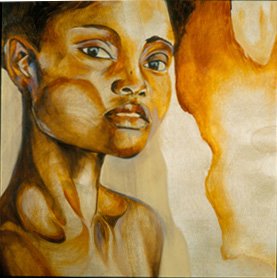JENNY CARPENTER
Lately, most of my studio visits are being made in preparation for upcoming group exhibitions, and there are few exceptions. Yet one recent visit was done out of the blue, and it proved quite a surprise. The artist is Jenny Carpenter, originally from Omaha, Nebraska, but who has traveled and lived in various locations around the U.S., and also Australia, Southeast Asia, Europe, and South Africa. These trips are made possible by her work as a freelance art director at various advertising agencies in cities where she has lived. As a New Yorker myself, and thoroughly ensconced in the New York art world, I was very surprised to hear how much the artist traveled. She was able to also take long periods of seclusion in her painting between bouts of travel and work, and New York remained for her a place to dream, not merely one to struggle.

I walked up the six flights of steps in a typical West Village red brick apartment building to be met by her at the threshold of her front door, a charming and somewhat stoical young woman, nervous since, as she said, there had not been many studio visits for her yet. Her small but well appointed home was preceded by a long narrow hallway, and one entered both the living room and the light of day. A wide green couch faced the windows, with a mostly northern exposure, though we know that nothing in the West Village faces exactly in one direction. The work was arranged all on one wall to my left, the artist sitting at my right ahead of me, just under those great village views.
In her emailed statement, she said that she painted oil on stained wood to allow the grain to influence the lines of a woman's face, with the scale of each image being a 1 to 1 ration on 12” x 12” birch board. I looked at these images and began to talk with her, and had a positive feeling. Here was some good work. A nice tight idea, a concept in the making garnered from her influences in the working world and how they merged with a particular notion of beauty, as well as all of the visual conceits that enter into the moment of aesthetic fascination when a beautiful woman appears on the printed page--a simulacra made palpable and commercial at the same time. Carpenter focuses mainly upon close-ups, and the images among these that I preferred were limited to a frame of the eyes, mouth, and cheekbones, with the eyes gazing deeply back at the spectator.

My main concern in learning to appreciate Carpenter’s work was my opinion on her sources. Since she does work in advertising, it is both natural and somewhat presumptuous that she would choose a type of imagery culled from the pages of fashion magazines. Yet the need to portray women’s faces--and she paints only women--has found perfect repository in the commercially viable and yet ultimately short lived use of such magazines. Here is where women are most notably typified, and if one wants a pictorial jumping-off point, there is no context more widespread than this, whether the point is to offer an alternative pictorial treatment or to freely sample the traditional modes of emotional expression which fashion models are forced to espouse. The specifically successful aspect of her portraits is that they portray all women in depicting the nameless ciphers used to exemplify the sort of passion that sells couture. Carpenter’s paintings zoom past the trappings of the industry and reveal the fuel that runs it: emotional intimacy. She qualifies the essential humanness which makes models more than visceral clotheshorses.


Comments